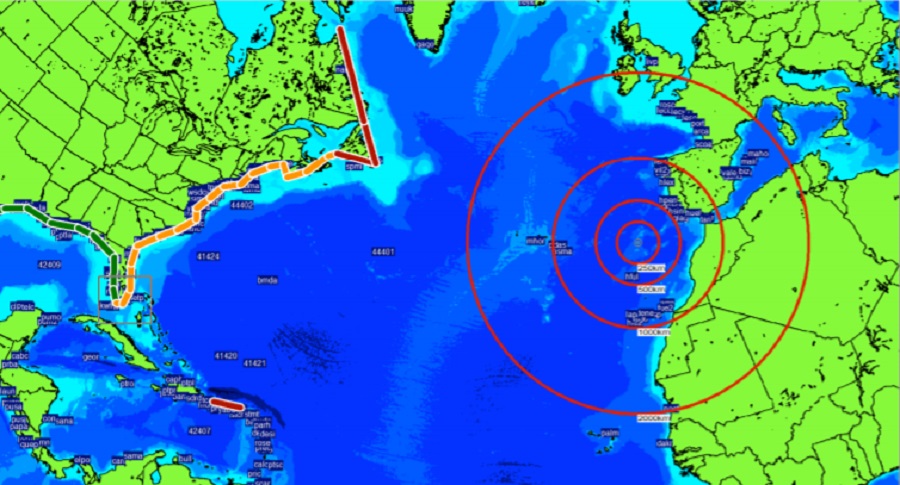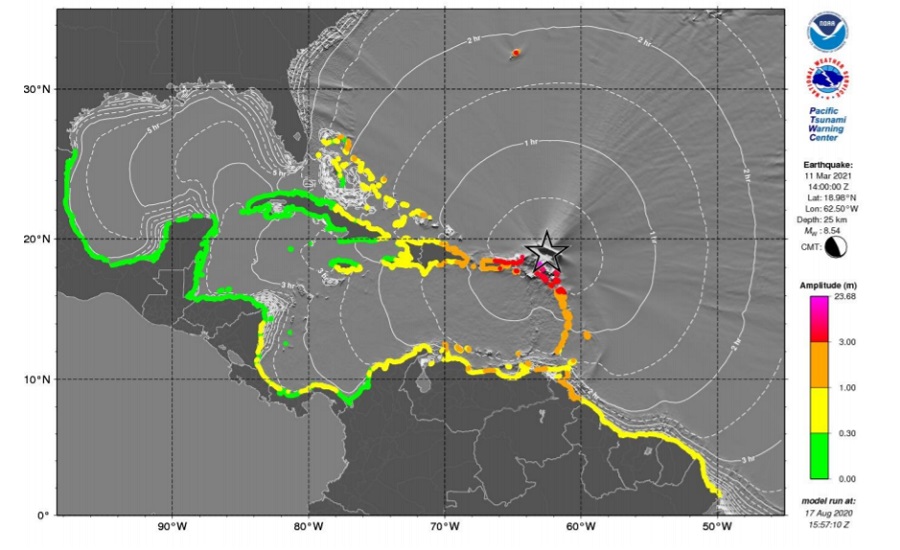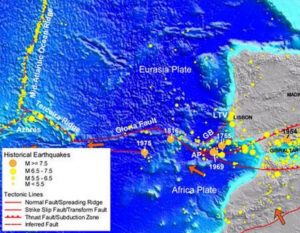
Are you and your local officials prepared for a potential destructive tsunami along the US east coast? While most associate tsunami threats with the Pacific basin, as last week’s strong New Zealand earthquakes and Tsunami Watch in Hawaii demonstrated, officials are preparing for the possibility of similar seismic activity in the Atlantic basin that could threaten the U.S. East Coast and the Caribbean by launching two separate drills over the next 2 weeks.
On March 11, through the CaribeWave ’21 Tsunami Warning System Exercise, officials will drill for two hypothetical earthquakes. At 9am ET, the Pacific Tsunami Warning Center will act as if a 8.0 magnitude earthquake strikes at 18.2 North 75.3 West near Jamaica. At the time time, an even more powerful 8.5 earthquake will strike near the Northern Lesser Antilles at 18.9 North 62.4 West. In the drill exercise, a simulated tsunami striking portions of Jamaica, Haiti, Cuba, and portions of Central and South America will be practiced with the first quake, while a broader, more impactful tsunami will be simulated with the second.

While the CaribeWave ’21 simulations will be sharing earthquake and tsunami advisory and warning information among officials, none of it should be released to the public. However, test messages will have the following text added in the event they do somehow end up in public channels:
...THIS MESSAGE IS FOR TEST PURPOSES ONLY... ...TEST TSUNAMI THREAT MESSAGE TEST... **** NOTICE **** NOTICE **** NOTICE **** NOTICE **** NOTICE ***** THIS IS A TEST MESSAGE. THIS MESSAGE IS ISSUED FOR INFORMATION ONLY IN SUPPORT OF THE UNESCO/IOC TSUNAMI AND OTHER COASTAL HAZARDS WARNING SYSTEM FOR THE CARIBBEAN AND ADJACENT REGIONS AND IS MEANT FOR NATIONAL AUTHORITIES IN EACH COUNTRY OF THAT SYSTEM. THIS IS A TEST MESSAGE. NATIONAL AUTHORITIES WILL DETERMINE THE APPROPRIATE LEVEL OF ALERT FOR EACH COUNTRY AND MAY ISSUE ADDITIONAL OR MORE REFINED INFORMATION. **** NOTICE **** NOTICE **** NOTICE **** NOTICE **** NOTICE *****
Days later, on March 17, another significant earthquake and tsunami drill will unfold. Unlike the CaribeWave ’21 event which focuses on preparedness in the Caribbean, the March 17 LANTEX 21 drill is designed to prepare the rest of the North American Coast for tsunami dangers.
The March 17 LANTEX21 drill will simulate an even more powerful 8.8 earthquake in the North Atlantic at 8am ET. The quake, centered at a depth of 9 miles at 36.0 North and 15.0 West will drive a potentially destructive tsunami towards the U.S. and Canadian East Coasts.
In the LANTEX21 drill, a Tsunami Warning will be “issued” for coastal areas of Newfoundland and Labrador from Cape Ray, Newfoundland to Cape Chidley, Labrador while a Tsunami Advisory will be “issued” for Florida, Georgia, South Carolina, North Carolina, Virginia, Maryland, Delaware, New Jersey, New York, Connecticut, Rhode Island, Massachusetts, New Hampshire, Maine, New Brunswick, Nova Scotia and the balance of the North American east coast from Cape Ray, Newfoundland to Flamingo, Florida.
These earthquake and tsunami drills will help bring awareness to the threats these areas could experience, allowing local officials and residents to be ready when an actual threat arrives. (If any real tsunami threat occurs during the time period of the exercise, the exercise will be terminated.)
Tsunamis are giant waves caused by earthquakes or volcanic eruptions under the sea. Out in the depths of the ocean, tsunami waves do not dramatically increase in height. But as the waves travel towards land, they build up to higher and higher heights as the depth of the ocean decreases. The speed of tsunami waves depends on ocean depth rather than the distance from the source of the wave. Tsunami waves may travel as fast as jet planes over deep waters, only slowing down when reaching shallow waters. While tsunamis are often referred to as tidal waves, this name is discouraged by oceanographers because tides have little to do with these giant waves.
The National Oceanic and Atmospheric Administration (NOAA) and the U.S. National Tsunami Hazard Mitigation Program (NTHMP) are providing the framework for the LANTEX21 tsunami exercise, which is being conducted to assist tsunami preparedness efforts throughout the Atlantic region. Recent earthquakes and their associated tsunamis, such as those in Samoa (2009), Haiti (2010), Chile(2010, 2015), and Japan (2011) attest to the importance of proper planning for tsunami response. Similar recent exercises in the Pacific and Caribbean Basins have proven effective in strengthening preparedness levels of emergency management organizations. This exercise will provide simulated tsunami alert messages from the NOAA/NWS National Tsunami Warning Center (NTWC) for the eastern coasts of Canada and the United States as well as Puerto Rico and the US/British Virgin Islands.

The area where the simulation will occur is not a stranger to violent tsunami-generating earthquakes. The Africa-Eurasia plate boundary extends from the Mid-Atlantic ocean ridge triple junction near the Azores eastward to the Strait of Gibraltar. Here, the Africa plate rotates counterclockwise relative to the Eurasia plate at a rate of about 4 mm/year. While that motion is relatively slow compared to other active plate boundaries found elsewhere around the world, several large magnitude earthquakes have occurred here. In 1755, there was a 7.6 magnitude quake there; in 1816, a magnitude 7.6 quake struck here; in 1969, a 7.9 earthquake struck here.
A modeled tsunami from the simulated LANTEX21 earthquake would impact the east coast of North America, with some areas impacted more than others. The model indicated a significant tsunami along the Canadian and Caribbean coasts, but with less impact elsewhere. Every earthquake has different characteristics, so what’s modeled in this simulation may be very different when a real earthquake does strike this region in the future.
During the simulated LANTEX21 tsunami event, test Tsunami Warning and Tsunami Advisory messages will be issued for residents of the U.S. East Coast, eastern Canada, and the Caribbean. As with the CaribeWave’21 endeavor, these bulletins shouldn’t make it out to the public. However, in some previous disaster exercises, such emergency bulletins were accidentally shared with the public. Just last week, a Tornado Warning alert was accidentally shared with hundreds of thousands of people via emergency cell phone alerts during a drill there. People shouldn’t be alarmed by any test messages; as with CaribeWave’21, LANTEX21 messages should be marked that it’s a drill and only a test message.
Tsunami Warning
A tsunami warning is issued when a tsunami with the potential to generate widespread inundation is imminent, expected, or occurring. Warnings alert the public that dangerous coastal flooding accompanied by powerful currents is possible and may continue for several hours after initial arrival. Warnings alert emergency management officials to take action for the entire tsunami hazard zone. Appropriate actions to be taken by local officials may include the evacuation of low-lying coastal areas, and the re-positioning of ships to deep waters when there is time to safely do so. Warnings may be updated, adjusted geographically, downgraded, or canceled. To provide the earliest possible alert, initial warnings are normally based only on seismic information.
Tsunami Advisory
A tsunami advisory is issued when a tsunami with the potential to generate strong currents or waves dangerous to those in or very near the water is imminent, expected, or occurring. The threat may continue for several hours after initial arrival, but significant inundation is not expected for areas under an advisory. Appropriate actions to be taken by local officials may include closing beaches, evacuating harbors and marinas, and the repositioning of ships to deep waters when there is time to safely do so. Advisories are normally updated to continue the advisory, expand/contract affected areas, upgrade to a warning, or cancel the advisory.
This will be the first LANTEX drill since the COVID-19 global pandemic. LANTEX20, and PACIFEX20, the Pacific-based tsunami drill, was scrubbed in 2020 due to pandemic fears. However, the CaribeWave ’20 exercise went on as scheduled on March 19, 2020. LANTEX and CaribeWave were held in 2018, 2016, and 2016 too.
For more information on the U.S. Tsunami Warning system, visit www.tsunami.gov.